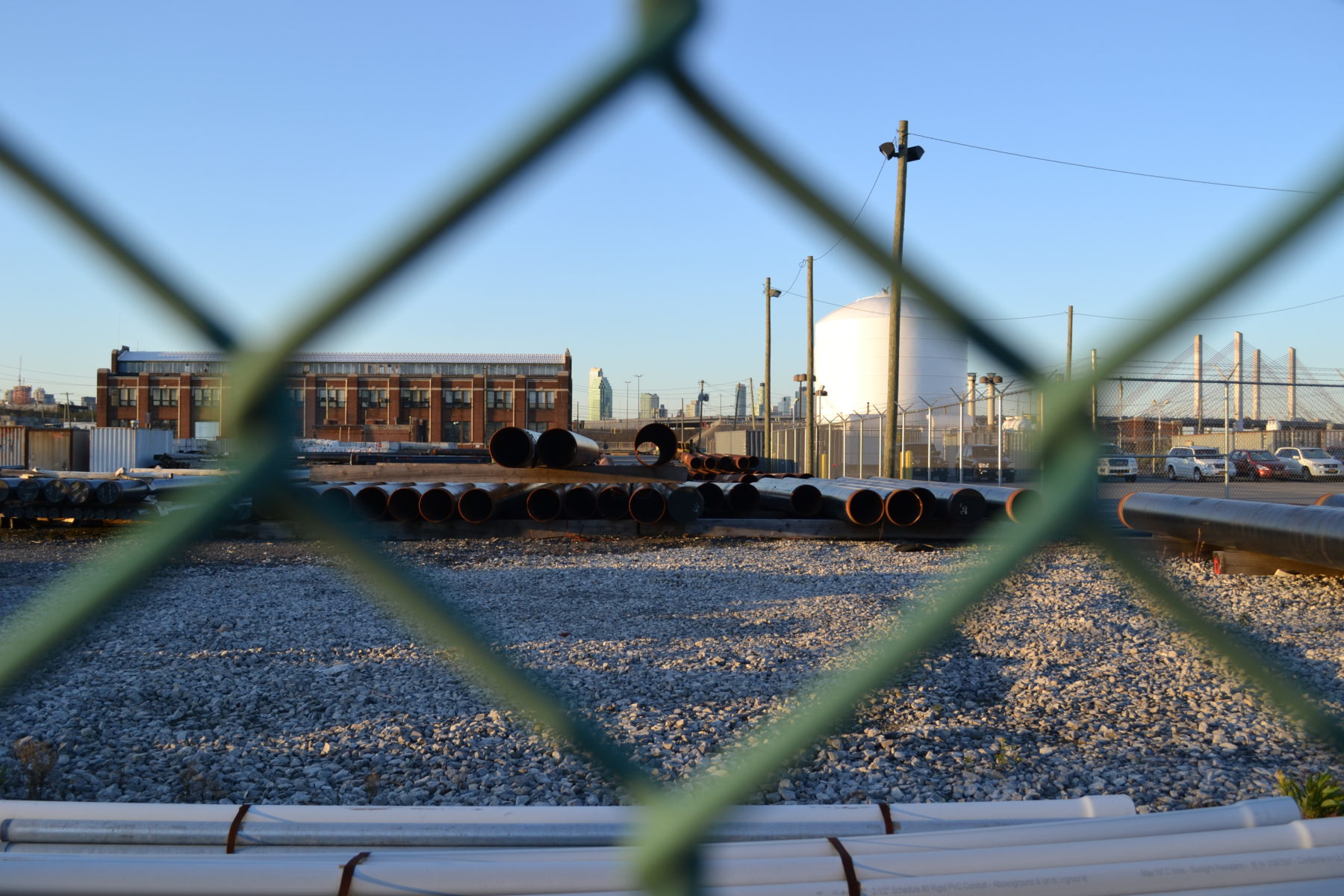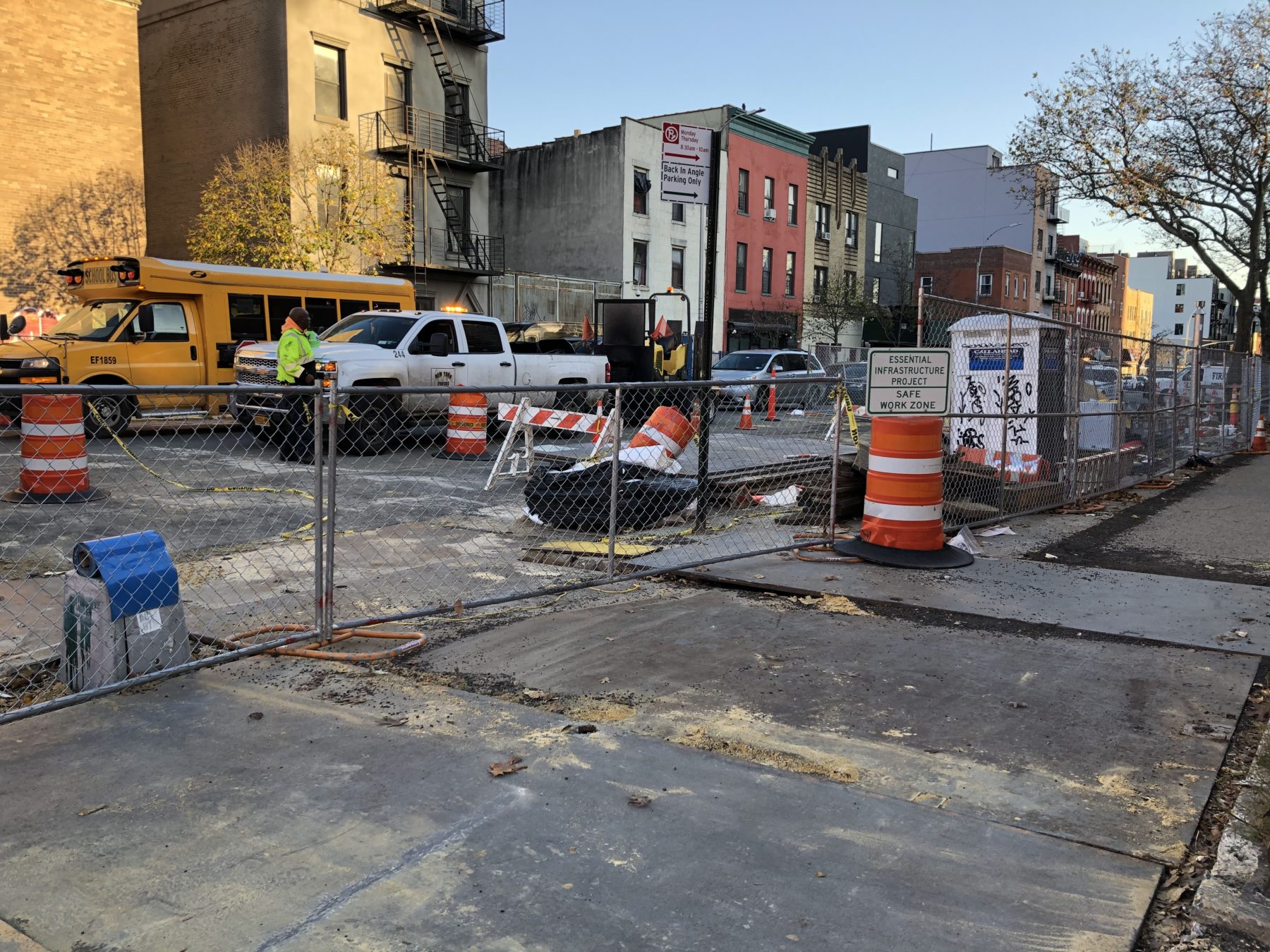For almost a year, environmental activists have marched, carried signs and chained themselves to equipment to protest a Brooklyn gas pipeline project, but the work is now nearing completion, and demonstrators may be running out of options.
When finished, seven miles of new underground gas mains will carry natural gas from Brownsville to the company’s depot in Greenpoint.
According to the National Grid website, the Metropolitan Natural Gas Reliability Project is essential to meet future energy demands, especially during colder months – a claim disputed by activists and a New York-based energy policy planner. The company says the project will also increase safety of the existing underground gas infrastructure, increase reliability of supply, and encourage economic growth and local investment.
Some residents and activists say the pipeline and its construction could harm public health. They also argue that National Grid failed to adequately communicate that the work involved new pipeline rather than maintenance, and they object to National Grid’s quest to raise rates by 18 percent.

“If they would have had a community meeting to see if people wanted to pay for it, it would have been very clear that the community would have said no,” said Lee Ziesche, community engagement coordinator for Sane Energy Project, a citywide activist organization that focuses on transitioning to renewable energy. “The process, since it is our money – it’s supposed to be in the public interest. You can’t see what’s in the public interest if you don’t know what the public wants.”
Although the pipeline work began in 2017, Ziesche said her group only learned about it in fall 2019, after National Grid submitted its rate-hike proposal. That rate case, which will ultimately be decided by the New York State Public Service Commission, is currently pending, but National Grid hopes that new rates will go into effect on April 1.
Community protests began in earnest last January, when Brooklyn Community Board 1 brought a National Grid representative to speak at a combined public hearing and board meeting. At least a dozen people spoke against the pipeline, and the board unanimously agreed on a resolution to oppose the project.
Since then, protesters have gathered more than 12,000 signatures on a petition to stop the project, and since February, demonstrators have staged weekly marches and rallies. In October, they chained themselves to pieces of the pipeline equipment to force construction to stop. Twelve people were arrested in October, but 22 people have been arrested and removed from two different construction sites this year.
Ziesche said National Grid should have started community engagement in 2016, when they proposed the project.
National Grid said it has acted properly. “Since the start of the project, we’ve had in place a community team that provides door-to-door outreach to residents and businesses directly ahead of where construction is taking place. Once we secure the necessary permits, our outreach to community stakeholders begins. All work we do is in accordance with permits and guidelines for conducting work in NYC streets,” spokesperson Wendy E. Ladd, said in a statement.
Community Board 1 member Willis Elkins questioned what information the company communicated, saying National Grid wasn’t always clear that the project included the installation of new pipelines.
He said the community board only learned about the scope of the pipeline project from Sane.
“We haven’t been put at ease in terms of what it means for people who are living and working near this pipeline,” said Elkins, who is also executive director of the Newton Creek Alliance, a community environmental group. “No one wants to live near fossil-fuel infrastructure.”
Roughly five miles of new gas main have been installed so far. The finished pipeline will stretch from Linden Boulevard in Brownsville, through Bedford-Stuyvesant, underneath Evergreen and Central Avenues in Bushwick, up through Williamsburg, to Greenpoint, at the National Grid depot on Maspeth Avenue. Domenick E. Graziani, a National Grid spokesperson, suggested in an email that the project will wrap up this winter but declined to specify a date.
Natural gas is cleaner than oil, but it is still a fossil fuel that generates air pollutants, greenhouse gas emissions and particulates when burned, according to a 2019 study by the University of Albany.
National Grid maintains that the pipeline will not harm residents. “We conduct regular surveys and monitoring and use technology to ensure the safety of our gas mains,” Ladd said in an email.
Public documents made available by the New York Public Service Commission say the project is specifically designed to increase natural gas capacity and provide natural gas when there are outages at the Greenpoint plant. It will not directly provide natural gas to the homes of customers in Brooklyn. A spokesperson for National Grid described it via email as akin to adding an extra lane to a very busy road to help reduce traffic.
In a virtual public meeting facilitated by National Grid on March 31 John Bruckner, president of National Grid New York, cited economic growth, development and the conversion of city buildings from oil to gas. “These factors have resulted in a substantial increase in the demand for natural gas, placing stress on our existing gas network and threatening National Grid’s ability to meet our customer’s demands when demand is at its peak,” he said.
An analysis conducted for the Eastern Environmental Law Center by Synapse Energy Economics contradicted National Grid’s claim that demand will strain existing supplies in the coming decade. The report argued that National Grid underestimated their ability to provide gas during peak demand periods, failed to account for increased electrification and assumed that the same rate of oil to gas conversions will continue, even though a large number of residential buildings have already converted under the NYC Clean Heat Program.
Activists also complained that the new pipeline will continue to enable the flow of natural gas obtained through hydraulic fracturing, or fracking. It’s unclear what percentage of gas in New York City is fracked, but the federal government estimates that fracked natural gas now makes up about two-thirds of the total gas produced in the United States. New York state forbids fracking.
National Grid did not respond directly to questions about the exact sources of the natural gas that will flow through the new pipeline.
Activists and residents also voiced concern about the construction process – including dust and fumes, emissions from idling trucks, and noise pollution – as well as an increased flow of natural gas through the densely populated urban area.
Elizabeth Geltman, a professor at the City University of New York’s Graduate School of Public Health and Health Policy, said the impact of infrastructure projects like the one in Brooklyn is hazy at best. “It’s really, really complicated,” she said. “Anybody who tells you otherwise is looking at it from a narrow lens.”

Communities surrounding the pipeline already have higher-than-average levels of fine particulate matter, the most harmful air pollutant, according to city community health profiles from 2018. There are also more natural gas pipelines in Brooklyn than any other borough according to New York Pipeline Awareness maps.
Gabriel Jamison, an environmental activist who trains young people to work in solar energy through the Solar Pioneer Program, noted that in his native Brownsville children ages 5 to 17 visit the emergency room for asthma at more than twice the citywide rate. “When you think about the respiratory problems residents already have, and we have food insecurity, and we live in a food desert … we’re already combatting all that,” he said.
Carlos Garcia, an energy policy planner for the New York City Environmental Justice Alliance, said its internal report outlines detrimental public health impacts from fossil-fuel infrastructure. “It shows that pollution and particulate matter, specifically carbon dioxide and nitrous oxide – the exact mix that are released from peaker plants [power plants that only run when demand is high] and power plants in New York City – significantly increases the likelihood of death and the contraction of COVID-19,” Garcia said.
Rolling Stone magazine reported in January that brine, a natural waste from oil and gas wells, carries concerning amounts of radioactivity. Since then, brine has been a focus of residents and activists in Brooklyn. Sane Energy Project asked National Grid if it planned to test for radioactivity, and National Grid customers and community members asked about it during the public meeting in March.
Geltman said no statute, legislation, or case law requires energy companies to test for radioactivity associated with natural gas pipelines. “The position of the industry is that there is not enough for it to matter,” she said. “I would like [those companies] to show me. If that’s the case, prove it.”
Complicating the evaluation of the natural gas pipeline is that natural gas is a fossil fuel that is also seen as an alternative-energy resource, Geltman said. New natural gas infrastructure plays a role in improving public health by updating leaky pipes and letting residents cook and heat their homes with an energy source that burns cleaner than oil.
“If you’re measuring it just in terms of emissions, then replacing an old pipeline may, in fact, be a net reduction of emissions,” she said. “If you’re talking about it giving increased access to fracked natural gas and encouraging it – that’s also a truth – it may mean we are encouraging use of natural gas longer than we should.”
New York City Council member Alicka Ampry-Samuel, who represents Bedford-Stuyvesant, Ocean Hill-Brownsville, East Flatbush, and Crown Heights, wants to see a transition away from fossil fuels and toward renewable energy in general. “We already have so many issues with respiratory diseases,” she said. “We should be doing what we can to work towards clean energy.”




